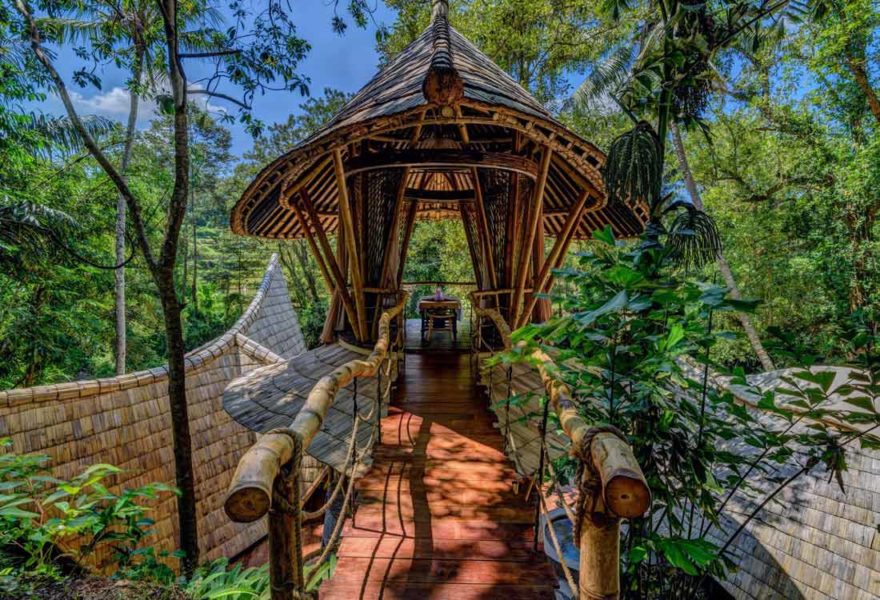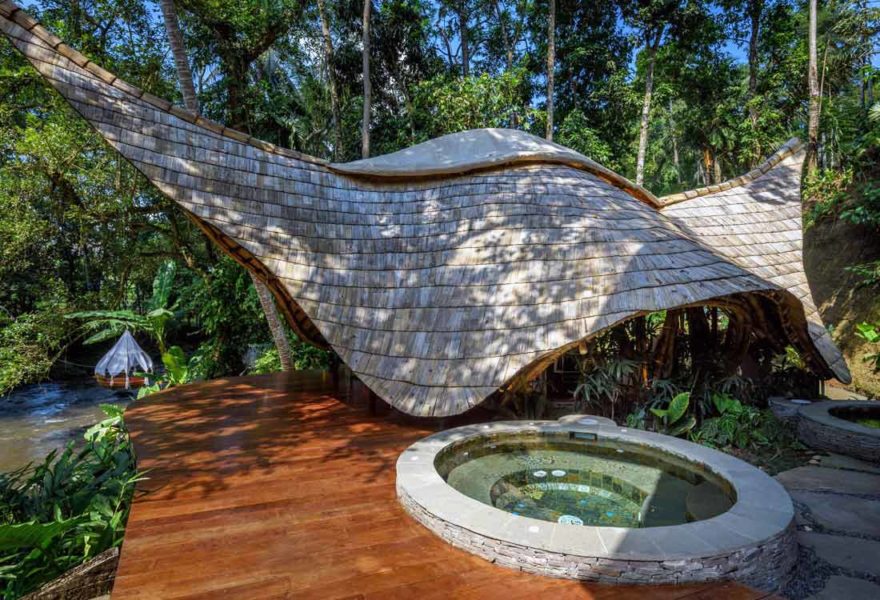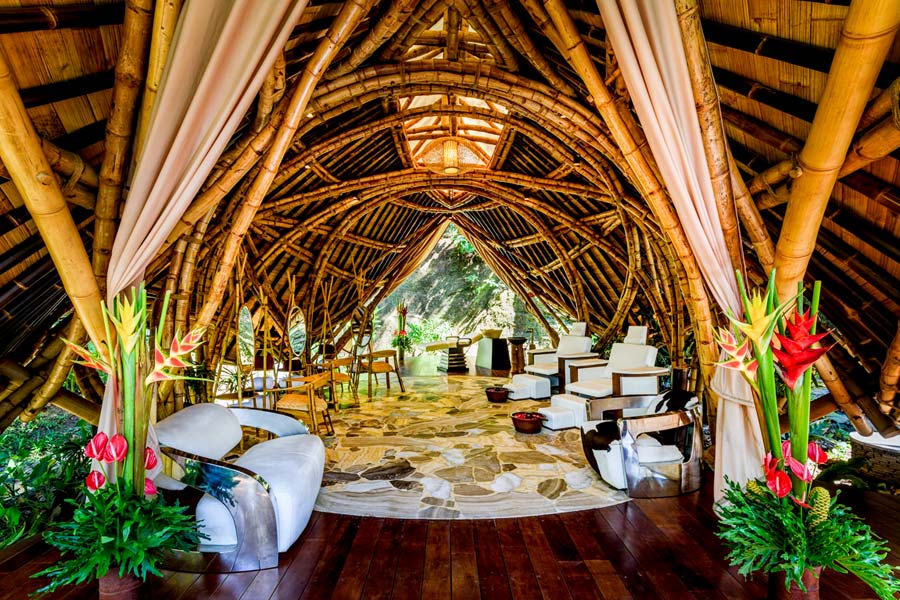Bamboo is a versatile material, used to make paper and bed sheets. It is also strong enough to use as scaffolding for skyscrapers and has a long history of use in vertical construction. In addtion, the material is in demand as flooring and decorative elements due to its biophilic design aesthetic.
The question researchers have been exploring is whether bamboo has the mechanical properties needed for use as a structural building material. As booming populations need more housing, governments, nongovernmental organizations (NGOs) and industry are looking for sustainable alternatives to meet the growing demand.
Bamboo may be that alternative. Its current structural use is mostly limited to temporary, low-cost structures or bespoke, luxury buildings. For bamboo to have widespread environmental and social impact, it must be validated as a commercially viable construction material.
What makes bamboo exciting
Bamboo checks many of the boxes of an eco-friendly construction material. It’s widely available and inexpensive, particularly in areas of the world with growing populations. As a lightweight local material, using bamboo minimizes the environmental costs of harvesting and transportation. Bamboo also sequesters carbon both as it grows and after harvest, making it potentially carbon-negative.
Bamboo’s renewability credentials far exceed timber. It can be harvested within three to five years of planting, as opposed to the decades timber requires. It regrows without needing to be replanted, which provides additional environmental benefits. Its large root network also protects against soil erosion and landslides.
Of course, none of this matters if bamboo’s mechanical properties can’t bear structural loads. A growing body of research shows that certain bamboo species have impressive and efficient mechanical properties, including possessing a strength-to-weight ratio equal or better than that of steel and lumber. Certain bamboos also have the compressive strength of concrete.

Source: IBUKU
“Bamboo has hundreds of fibers surrounded by lignin matrix that bind the fibers together,” said Dr. Alireza Javadian, a co-author on numerous studies on bamboo’s potential in construction. “These fibers are a major point of load transfer that provides its strength.”
Bamboo’s strength and flexibility have proven better at absorbing seismic activity than more common building materials. A collection of bamboo houses withstood a 7.6 magnitude earthquake in Costa Rica in 1991, while wood and concrete houses in the same area suffered damage.
[SEE ALSO: The Art of Plastics in Construction]
Bamboo’s greatest weakness is its poor durability in its natural state. The material attracts insects and fungus, which cause decay, and untreated bamboo structures don’t last more than a few years. Part of the growing body of research looks at how treated and engineered bamboo products compare to steel, concrete and timber. They’re looking at its potential to replace steel in reinforced concrete and working to create a foundation for strength grading that could encourage development of the building standards and codes bamboo needs for wider adoption in larger construction projects.
Architects are also exploring how complex structures built primarily with bamboo might look and function in expanding urban spaces.
Curious why 3 million AECO professionals worldwide use Bluebeam to finish projects faster?

Industry, NGOs partner to push bamboo as a construction material
Widuz is a bio-based materials startup established by researchers who were part of a seven-year collaboration between the Future Cities Laboratory, the Singapore National Research Foundation and ETH Zurich. Javadian, Widuz’ CEO, was part of that collaboration, which focused on testing the mechanical and physical properties of a proprietary engineered bamboo product, BVL, now sold by Widuz.
BVL is made up of 90% bamboo fibers and 10% bio-compatible binder. According to Javadian, the company’s testing of BVL showed that “it was possible to replace steel reinforcement in concrete for low-rise housing up to three or four stories.” Widuz has built a prototype, two-story house using BVL-reinforced concrete and BVL walls and beams.
Widuz has recently partnered with the nonprofit Smiling Gecko’s bamboo project. Smiling Gecko is based in Cambodia, a country with a history of bamboo vernacular construction and plentiful bamboo forests. It currently runs a primary school where bamboo netting is used underneath a clay tile roof to keep internal temperatures down.

Source: IBUKU
Widuz will be building a two-story secondary school using BVL for Smiling Gecko. The startup is setting up its first factory on Smiling Gecko property in Cambodia as well, as part of the organizations’ long-term partnership.
Hannes Schmid, photographer and founder of Smiling Gecko, said that the nonprofit organization will also host a laboratory to continue bamboo research with universities. Schmid said that Cambodia “is growing and the people want room; they want houses. So we urgently need alternative materials. There’s no other way around. But there’s so many different types of bamboo and only a few that have the stability to replace steel.”
Building industry confidence in bamboo
There are more than 1,500 bamboo species and even more subspecies. Only a few have potential as any sort of structural construction material. The range of variables in researchers’ testing and documentation regarding bamboo’s potential as a construction material complicate the adoption of building standards and codes.
Building in Cambodia is possible because local regulations only require that full designs be submitted to local architects and structural engineers for approval. The lack of construction standards and building codes for bamboo and engineered bamboo are barriers to wider commercialization. Without building standards and codes, architects and engineers will be reluctant to specify bamboo in their plans despite its clear environmental advantages and aesthetic qualities.
“More support is needed from the industries to put in the energy and work with governmental agencies and certification agencies to make engineered bamboo available under building codes,” Javadian said.












